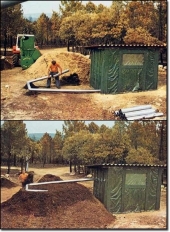




 1
1








William Bronson wrote:I definitely would not aerate the sides of the pile.
Maybe seal the whole thing, put a solar chimney on top and supply "preheated" air into the bottom?
The preheated air could come from an earth tube, a solar collector, or a combination of the two.








Jeremy Baker wrote:The more heat it generates the more natural draft it would have. I’m wondering about mixing the pile so it’s hot? Ive got similar questions for the diy composting toilet I’m designing. How to vent it? How to contain it? How to regulate it? Is mixing necessary? Etc.




![Filename: CompostHeatedGreenhouse.jpg
Description: [Thumbnail for CompostHeatedGreenhouse.jpg]](/t/155986/a/132754/CompostHeatedGreenhouse.jpg)
An important distinction: Permaculture is not the same kind of gardening as organic gardening.
Mediterranean climate hugel trenches, fabuluous clay soil high in nutrients, self-watering containers with hugel layers, keyhole composting with low hugel raised beds, thick Back to Eden Wood chips mulch (distinguished from Bark chips), using as many native plants as possible....all drought tolerant.
 1
1




An important distinction: Permaculture is not the same kind of gardening as organic gardening.
Mediterranean climate hugel trenches, fabuluous clay soil high in nutrients, self-watering containers with hugel layers, keyhole composting with low hugel raised beds, thick Back to Eden Wood chips mulch (distinguished from Bark chips), using as many native plants as possible....all drought tolerant.
















An important distinction: Permaculture is not the same kind of gardening as organic gardening.
Mediterranean climate hugel trenches, fabuluous clay soil high in nutrients, self-watering containers with hugel layers, keyhole composting with low hugel raised beds, thick Back to Eden Wood chips mulch (distinguished from Bark chips), using as many native plants as possible....all drought tolerant.

|
Stop it! You're embarassing me! And you are embarrassing this tiny ad!
GAMCOD 2025: 200 square feet; Zero degrees F or colder; calories cheap and easy
https://permies.com/wiki/270034/GAMCOD-square-feet-degrees-colder
|



